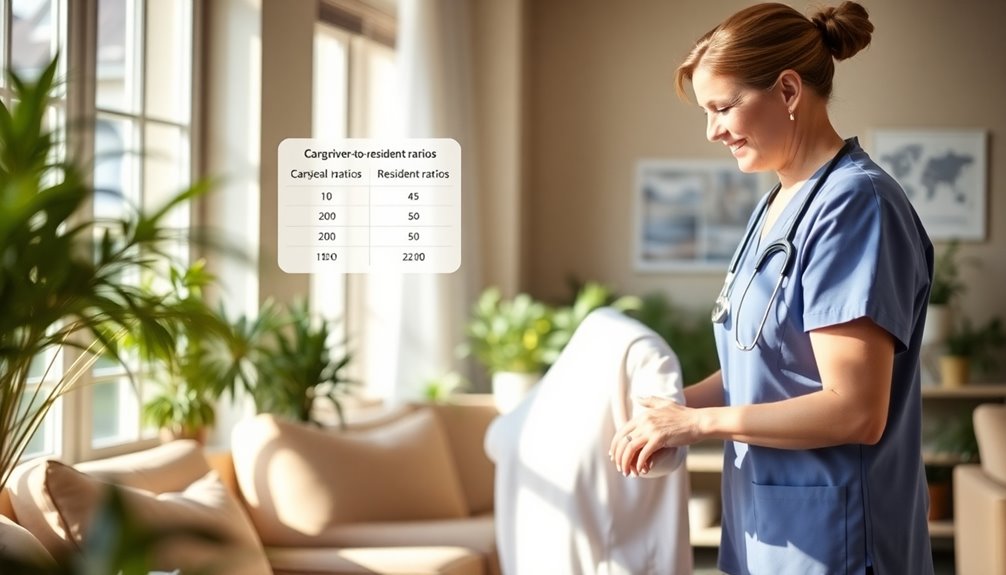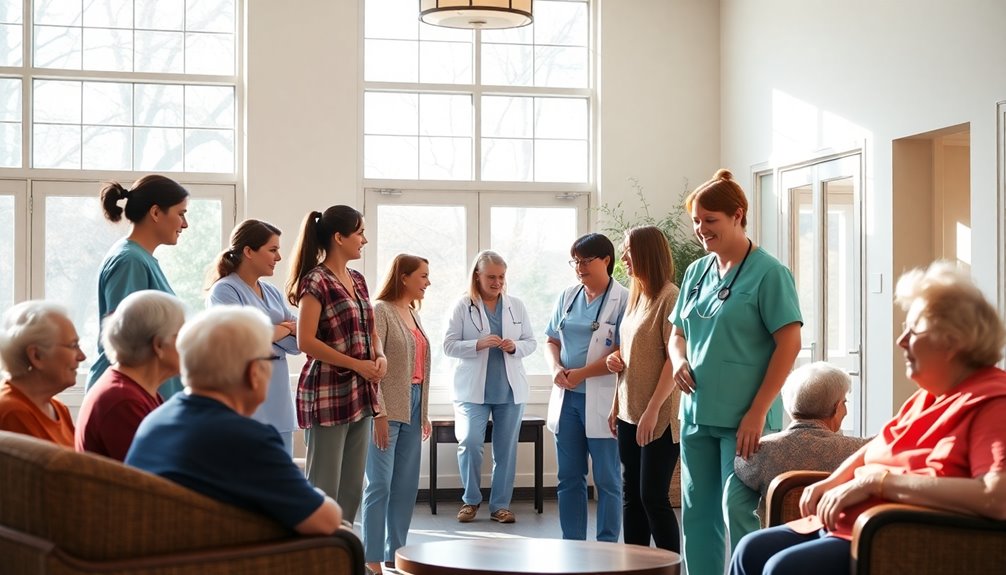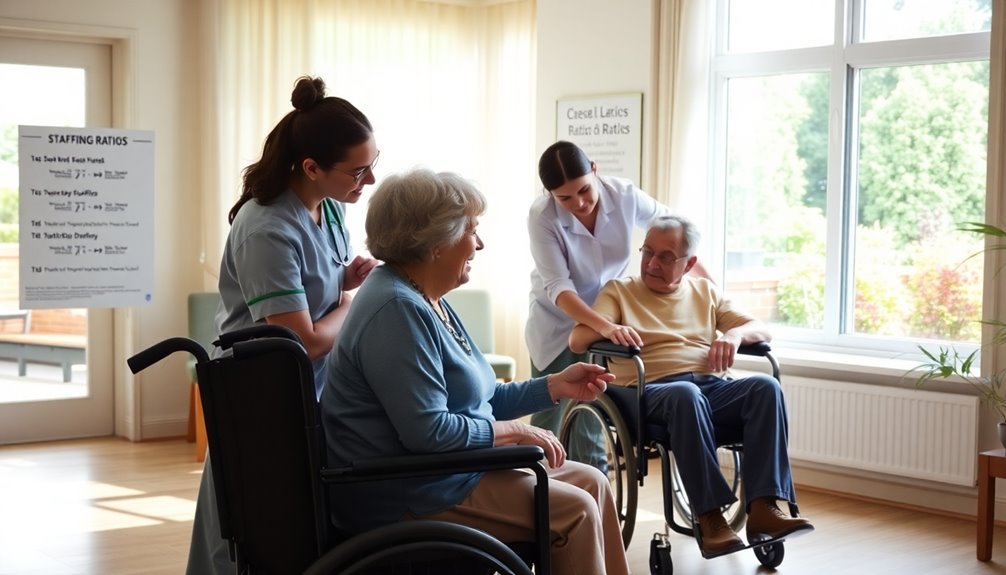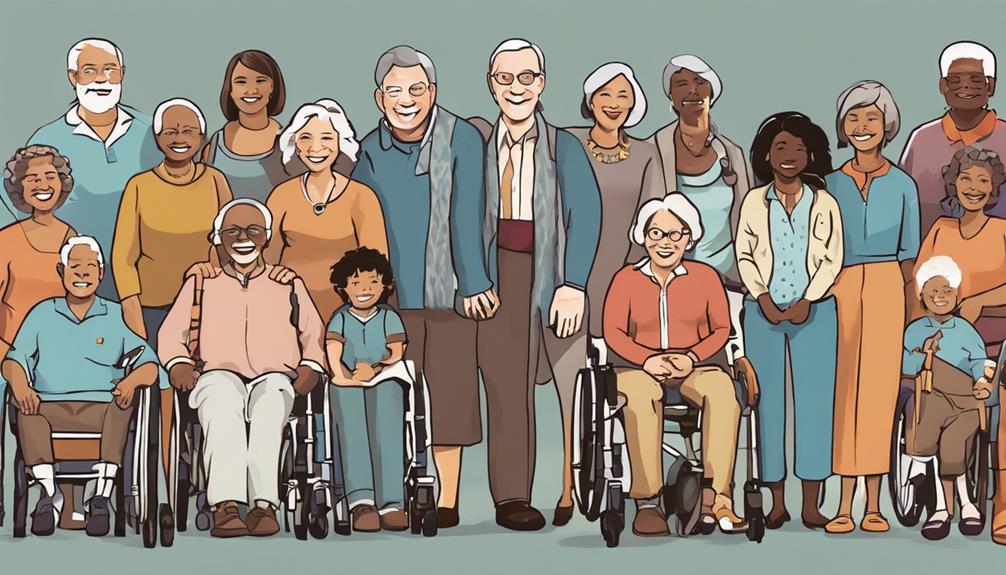In assisted living, the typical caregiver-to-resident ratio is 1 for every 8 residents during the day and can be as high as 1 for every 15 residents at night. This ratio guarantees residents receive adequate attention and support, especially those with significant care needs. The quality of care often improves with higher staffing numbers and better-qualified caregivers. There's more to reflect upon when evaluating care quality and staffing levels, so keep exploring this important topic.
Key Takeaways
- Typical caregiver-to-resident ratios are 1:8 during the day and 1:15 at night in assisted living facilities.
- Ideal staffing ratios range from 1:6 to 1:20, depending on residents' care needs.
- Higher caregiver numbers lead to better response times and personalized care for residents.
- Staffing levels can fluctuate due to varying resident needs and external factors like weather.
- Caregiver qualifications and training significantly impact the quality of care provided to residents.
Understanding Staff-to-Resident Ratios

When considering assisted living facilities, understanding staff-to-resident ratios is essential for ensuring quality care.
The typical staff-to-resident ratio is about 1 caregiver for every 8 residents during the day, but this can rise to 1:15 during night shifts. State regulations often dictate these ratios, influencing the level of care residents receive. These staffing ratios are crucial as they directly impact the quality of care provided to residents, particularly during high-demand times. Facilities must also consider other factors like employee retention and overall budget constraints, which in turn affect the caregiver hourly rate breakdown. By ensuring a balanced and sufficient staffing level, facilities can enhance care standards and foster a supportive environment for both residents and caregivers.
Higher caregiver numbers lead to better response times and personalized care, especially for those needing assistance with daily activities or suffering from memory issues.
As you evaluate potential communities, be sure to ask about both daytime staffing levels and nighttime shifts. Knowing the qualifications of caregivers will also help you gauge the quality of care your loved one will receive in their new environment.
The Importance of Care Needs in Staffing

Understanding the specific care needs of residents is essential for determining the appropriate staffing levels in assisted living facilities. The staff-to-resident ratio directly impacts the quality of personalized care provided.
Higher staffing ratios are critical for residents requiring significant assistance, while those with minimal care needs can thrive with lower ratios. It's important to reassess staffing ratios regularly to guarantee adequate staffing levels match residents' evolving care needs.
Ideal staffing ratios typically range from 1:6 to 1:20. By prioritizing staff qualifications and aligning them with care needs, you can enhance resident satisfaction and improve overall health outcomes.
A well-calibrated caregiver-to-resident ratio leads to better support and a more fulfilling living experience for seniors.
Flexibility and Variability in Staffing Levels

Flexibility in staffing levels is vital for meeting the ever-changing needs of residents in assisted living facilities. Staffing ratios can fluctuate due to factors like weather, staffing shortages, and varying resident care needs.
For instance, night shifts usually have a higher staff-to-resident ratio, often around 1:15, since activity levels decrease. Assisted living communities must adapt staffing levels quickly, with other staff stepping in during emergencies, showcasing their flexibility.
A well-structured staffing plan is essential to maintain resident safety and care quality during these fluctuations. Continuous monitoring and reassessment of staffing adequacy guarantee that resident care needs are met, providing the best support even when variability arises in caregiver availability throughout the day.
Key Questions to Ask Assisted Living Facilities

Finding the right assisted living facility can be overwhelming, but asking the right questions can help ease your decision-making process.
Start by inquiring about the caregiver-to-resident ratio during the day and at night, as this reveals the level of individualized care and support availability your loved one will receive.
Check if caregivers are CPR certified, guaranteeing resident safety in emergencies.
Ask about the frequency of nurse availability on-site, which greatly affects quality of care.
Additionally, discuss how the facility addresses personal care needs and whether the trained staff are prepared for specific medical conditions.
These questions will help you gauge the overall environment and ensure your loved one receives the best possible care.
Caregiver Qualifications and Standards

When considering assisted living, it's essential to understand caregiver qualifications and standards.
You'll find that training requirements and certification can vary greatly between communities.
Make sure to ask about the specific qualifications and any licensing standards that apply to the caregivers who'll be providing care.
Caregiver Training Requirements
Although assisted living communities often face less stringent staffing requirements than nursing homes, understanding caregiver training requirements is essential for guaranteeing quality care.
Caregiver qualifications can vary widely; many care staff receive on-the-job training, while others may be certified nursing assistants (CNAs). Depending on the health services offered, federal standards might require a registered nurse (RN) on duty in certain communities.
However, state regulations dictate caregiver qualifications and can differ greatly, with many states lacking stringent mandates for training and certification.
To promote quality assurance, it's advisable to consult with assisted living community staff about their training programs. This guarantees that caregivers are adequately prepared to meet the unique needs of residents, providing the best possible care.
Certification and Licensing Standards
Certification and licensing standards for caregivers in assisted living communities play an essential role in ensuring residents receive quality care.
While staffing requirements are typically less stringent than in nursing homes, caregiver qualifications vary. Many caregivers receive on-the-job training, and some may hold certifications as nursing assistants.
State regulations often dictate these qualifications, but many states lack strict mandates regarding training hours and certifications for assisted living staff.
It's important to highlight that federal standards might require a registered nurse to be on duty at certain times.
To guarantee appropriate care standards, families should consult with community staff about the qualifications and training of their caregivers, ensuring a competent health care environment for their loved ones.
Regulatory Guidelines for Staffing Ratios

While staffing ratios in assisted living facilities are primarily regulated at the state level, the lack of uniformity can create confusion for providers and families alike. Understanding the regulatory guidelines is vital for guaranteeing resident needs are met.
Here are some key points:
- Only twelve states have minimum staffing requirements.
- Most states mandate at least one caregiver on-site for safety.
- A common staff-to-resident ratio recommendation is one caregiver for every four residents.
- Some states, like Alabama, require specific training for administrators and staff.
These staffing ratios guarantee adequate attention and care, but remember, the presence of qualified staff is essential for an effective assisted living facility.
Strategies for Improving Staffing Ratios

Ensuring adequate staffing ratios in assisted living facilities requires proactive strategies that go beyond regulatory guidelines.
You can improve the staff-to-resident ratio by implementing technology solutions like electronic health records and scheduling software, which enhance caregiver efficiency.
Investing in training and professional development not only boosts job satisfaction but also reduces turnover rates, helping maintain higher staff ratios.
Consider utilizing flexible staffing models, including part-time or on-call caregivers, to adapt to varying resident needs.
Establish partnerships with local nursing programs to create a pipeline for recruiting caregivers, improving overall staffing levels.
Finally, advocate for policy changes at the state level to establish minimum staffing ratio requirements, ensuring consistent quality care across assisted living communities.
Frequently Asked Questions
What Is the Ratio of Caregivers to Residents?
When you ask about the ratio of caregivers to residents, it varies considerably depending on the facility and its specific needs.
Generally, you might see a ratio of around 1:8 during the day, increasing to 1:15 at night.
However, for specialized care, like memory support, the ratio could improve to 1:5 or 1:6.
Always check the specific ratios at a facility, as they can greatly influence the quality of care your loved one receives.
What Is the Nurse to Patient Ratio in Assisted Living?
In assisted living, the nurse-to-patient ratio typically ranges from 1 nurse for every 10 to 15 residents during daytime shifts.
However, this can vary based on state regulations and individual facility policies.
You might find that facilities with higher care needs, like memory care units, have lower ratios to guarantee residents receive adequate attention.
It's essential for facilities to continually assess care needs, adjusting staffing levels as necessary to meet residents' evolving health conditions.
How Often Should You Visit Your Parents in Assisted Living?
Imagine your visits as a warm sunbeam breaking through the clouds, brightening your parents' day. You should visit them at least once a week to nurture their emotional well-being.
Engage with the staff during your time there; it'll give you insight into their care. Participate in activities to boost their social connections.
Always communicate with your parents about how they feel regarding your visits, ensuring they feel supported but not overwhelmed.
What Is the Ratio of Staff to Residents in a Care Home?
In a care home, the staff-to-resident ratio can vary greatly.
Generally, you'll find it around 1:8, but this can change based on state regulations and the specific needs of the residents.
During night shifts, the ratio might increase to 1:15, as fewer residents require assistance.
When considering a care home, it's important to assess how these ratios align with the care needs of your loved ones to guarantee they receive adequate support.
Conclusion
In assisted living, it's essential to understand that the average caregiver-to-resident ratio often hovers around 1:6, but this can vary based on care needs. This means that for every six residents, there's typically one caregiver available. A well-staffed facility can greatly enhance the quality of life for residents, ensuring they receive the personalized attention they deserve. When exploring options, remember that a higher ratio often translates to better care and more meaningful interactions.









